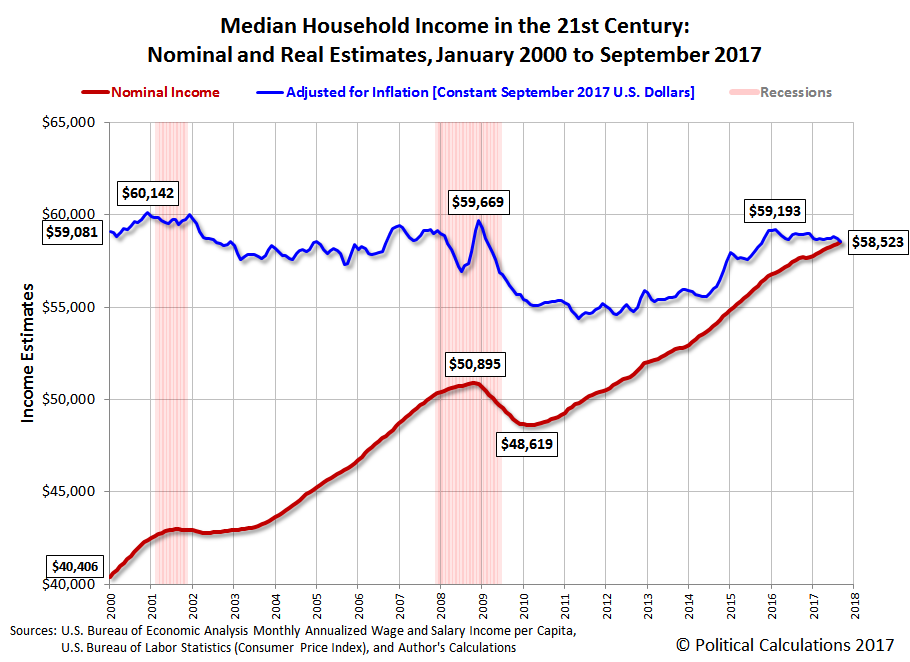Median household income in the U.S. rose to to $58,523 in September 2017, up nearly 0.2% from our previous estimate of $58,419 for August 2017. The following chart shows our estimates for the trends for both nominal (red) and inflation-adjusted median household income (blue) from January 2000 through September 2017.
In terms of current U.S. dollars, the most recent trend for median household income in the U.S. has been slowly rising since January 2017. However, after adjusting the nominal income data to be in terms of inflation-adjusted, constant September 2017 U.S. dollars, we can see that since January 2017 has trended mostly flat until recent months, where it has recently dipped thanks to the higher rates of inflation recorded since July 2017.
We believe that most of that change reflects recent increases in the price of oil following the supply disruption of domestic U.S. production following Hurricane Hugo combined with an increase in foreign demand since the end of June 2017, which has reversed what had been a downward trend for these prices.
The methodology for the approach we've developed to generate these median household income estimates is described here. In generating inflation-adjusted portion of the Median Household Income in the 21st Century chart above, we've used the Consumer Price Index for All Urban Consumers (CPI-U) to adjust the nominal median household income estimates for inflation, so that they are expressed in terms of the U.S. dollars for the month for which we're reporting the newest income data.
Notes
For the just released personal income data, the BEA revised the figures for just the previous two months from their previously reported levels, which we've updated in this month's chart. As in previous months (or at least since June 2017 when we began posting our monthly estimates of median household income, the magnitude of the revisions continue to be tiny (on the order of +/-0.04%), with minimal impact to our estimates from one month to the next.
On a final note for this month, we discovered that our monthly median household income estimates have been incorporated into Requisite Press' Auto Buyer's Affordability Index, which they indicate is "a consumer-focused measure of average new-car price affordability. The purpose of the index is to provide regular, on-going consumer awareness of affordability considerations for improved household financial health."
Kind of like what we do for median new home sale prices in the U.S., but for cars - check it out!
Data Sources
U.S. Bureau of Economic Analysis. Table 2.6. Personal Income and Its Disposition, Monthly, Personal Income and Outlays, Not Seasonally Adjusted, Monthly, Middle of Month. Population. [Online Database (via Federal Reserve Economic Data)]. Last Updated: 30 October 2017. Accessed: 30 October 2017.
U.S. Bureau of Economic Analysis. Table 2.6. Personal Income and Its Disposition, Monthly, Personal Income and Outlays, Not Seasonally Adjusted, Monthly, Middle of Month. Compensation of Employees, Received: Wage and Salary Disbursements. [Online Database (via Federal Reserve Economic Data)]. Last Updated: 30 October 2017. Accessed: 30 October 2017.
U.S. Bureau of Labor Statistics. Consumer Price Index for All Urban Consumers: All Items, Monthly, Not Seasonally Adjusted. [Online Database (via Federal Reserve Economic Data)]. Last Updated: 13 October 2017. Accessed: 30 October 2017.
Labels: median household income
Welcome to the blogosphere's toolchest! Here, unlike other blogs dedicated to analyzing current events, we create easy-to-use, simple tools to do the math related to them so you can get in on the action too! If you would like to learn more about these tools, or if you would like to contribute ideas to develop for this blog, please e-mail us at:
ironman at politicalcalculations
Thanks in advance!
Closing values for previous trading day.
This site is primarily powered by:
CSS Validation
RSS Site Feed
JavaScript
The tools on this site are built using JavaScript. If you would like to learn more, one of the best free resources on the web is available at W3Schools.com.
